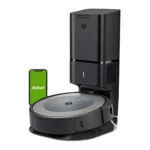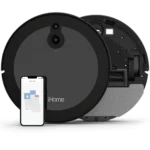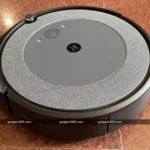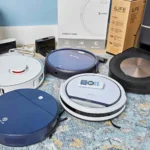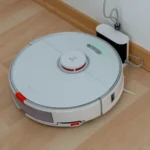When it comes to keeping our homes clean and tidy, many of us struggle to keep up with the day-to-day cleaning tasks. This is where robot vacuum cleaners come in. These futuristic devices have revolutionized home cleaning by taking on the task of daily maintenance. With their advanced technology and features, it’s no wonder that they are becoming a must-have item for any modern home. In this article, we will take a look at the benefits of robot vacuum cleaners, how they work, the types of robot vacuum cleaners on the market, features to look for when buying one, and top brands to consider. So buckle up and get ready to dive into the world of robot vacuum cleaners!
Benefits of Robot Vacuum Cleaners
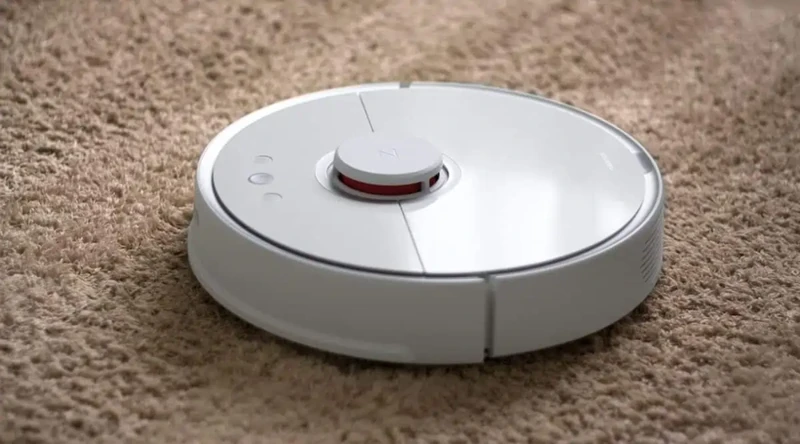
Have you ever wished for a magic wand that can take care of your home cleaning without breaking a sweat? Well, with the advancement of technology, now you have one – the robot vacuum cleaners. These smart gadgets are revolutionizing the way we clean our homes, making the process more efficient, less time-consuming, and much simpler. But that’s not all, there are numerous other advantages of robot vacuums that make them a worthy investment. Let’s dive into the benefits of robot vacuum cleaners and see why they are creating a buzz in the cleaning industry.
Saves Time and Effort
Robot vacuum cleaners are an excellent investment for anyone who wants a clean home without putting in the extra time and effort. With the use of advanced technologies, these machines can help homeowners save time and energy, making their daily routines more efficient.
Here are some of the ways that robot vacuum cleaners save time and effort:
| Benefits | Description |
|---|---|
| Automated Cleaning | With the ability to set a cleaning schedule, robot vacuums can clean your home while you’re doing other things or not at home at all. This means you don’t have to be physically present or spend time cleaning yourself. |
| No More Wires/Cords | Unlike traditional vacuum cleaners that require a power outlet, robot vacuums operate on rechargeable batteries. With no cords or wires, you can save time setting up and putting away any equipment. |
| Multi-Surface Cleaning | Robot vacuums can clean various surfaces like carpet, hardwood, and tile floors without any need for you to switch cleaning tools. They also get dust and debris from difficult-to-reach areas, such as under beds, sofas, and cabinets. |
Investing in a robot vacuum cuts down the time and effort involved in cleaning your home, giving you more time to do other things you love. The efficiency and effectiveness of these machines means more time spent with your family or doing the things you enjoy.
If you want to learn more about how robot vacuums can help you save time and effort, take a look at this article about the benefits of robot vacuums.
Improves Health and Hygiene
Robot vacuum cleaners not only save time and effort but also improve health and hygiene in homes. Traditional vacuum cleaners can stir up dust, pollen, and other allergens into the air, which can be harmful to those who suffer from allergies, asthma, or other respiratory issues. However, robot vacuums are equipped with advanced HEPA filters that capture even tiny particles, preventing them from being released back into the air.
In addition to capturing allergens, robot vacuum cleaners can also help eliminate bacteria and other harmful microorganisms. Some models are designed with UV-C lights that can sterilize surfaces while cleaning, ensuring a deep and thorough cleaning that traditional vacuum cleaners may not be able to provide.
Moreover, robot vacuum cleaners can prevent the spread of pet dander and hair in homes with pets. Many models have powerful suction capabilities that can remove pet hair and other debris from carpets and floors that may cause allergies in humans.
By using a robot vacuum cleaner, you can minimize the risk of exposure to harmful airborne particles and microorganisms, especially for those with respiratory issues in your home. Additionally, ensuring a clean home environment can lead to a better quality of life, and robot vacuums can help in achieving that.
Smart mapping and navigation features on some models can also help with cleaning efficiently and thoroughly, ensuring that every corner of your home is clean and healthy. By using these features, robot vacuums can maximize cleaning coverage, and you can read more about it and other features in our article “Maximize Cleaning Coverage with a Robot Vacuum”.
Investing in a robot vacuum cleaner can provide many benefits for your home, including healthier and safer living conditions for you and your family. In our article “Robot Vacuum vs. Traditional Vacuum: Costs and Benefits”, you can find more in-depth analysis about the benefits and drawbacks of using a robot vacuum cleaner.
Enhances Home Decor
One of the lesser-known benefits of robot vacuum cleaners is how they enhance the overall decor of your home. Traditional vacuum cleaners are often bulky and inconvenient to store, while robot vacuums are compact and can easily be hidden away when not in use.
Additionally, many robot vacuum cleaners come in sleek, modern designs that can compliment any home decor. Some models even come in multiple colors to fit your personal style. This means that not only are robot vacuums functional, but they can also add a touch of style to your home.
Another way that robot vacuums can enhance your home decor is by eliminating the need for unsightly cords and cables. Traditional vacuums require cords to be plugged into an outlet and dragged around the house, often leading to tangled messes and unpleasant visual clutter. Robot vacuums, on the other hand, are generally wireless and run on rechargeable batteries, eliminating the need for cords altogether.
In addition to removing visual clutter, robot vacuums can also help reduce noise pollution in your home. Traditional vacuum cleaners can be loud and disruptive, making it difficult to hear your thoughts or enjoy your day-to-day activities. Robot vacuums, on the other hand, are designed to be quieter and less disruptive, allowing you to clean your home without disturbing the peace.
Lastly, robot vacuums can also improve the air quality in your home. Many models come equipped with advanced HEPA filters, which capture even the smallest dust and allergen particles that can cause respiratory issues. This means that not only will your home be cleaner, but the air you breathe will be healthier too.
The benefits of robot vacuum cleaners reach far beyond just cleaning. They can enhance the overall aesthetic of your home, remove visual clutter and reduce noise pollution. Additionally, they can improve the air quality in your home, making it a healthier environment to live in.
For more information on the benefits of robot vacuum cleaners, check out our article on Simplifying Cleaning with Robot Vacuums.
How Do Robot Vacuum Cleaners Work?
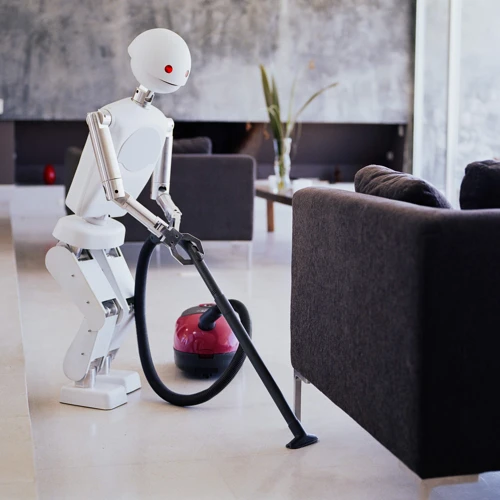
Robot vacuum cleaners are high-tech devices that are changing the way people clean their homes. These robots use a combination of sensors, algorithms, and artificial intelligence to navigate around the home and clean floors without human intervention.
At the core, robot vacuum cleaners work by mapping a room and creating a path to follow. They use sensors such as infrared, laser, and bump sensors to detect obstacles to avoid and determine their location within the room. They may also use cameras and lighting to better navigate around the room. The robot then calculates a cleaning path that is the most efficient and covers the most surface area using its sensors, so that no spot gets left out.
Once the path is mapped and the cleaning begins, the robot vacuum cleaner uses rotating brushes or rollers to sweep up dirt, dust, and debris off the floor. There are usually two types of brushes used in robot vacuums – one to loosen up the dirt and debris from the floor, and the other to sweep it into the dustbin of the robot vacuum.
Robot vacuums also come equipped with a variety of cleaning modes. Some of the common modes include spot cleaning, edge cleaning, and automatic cleaning. “Spot cleaning” is a mode that focuses on cleaning up a specified area repeatedly by running around in circles (useful if there is a major spill). “Edge cleaning” is a mode that allows the robot vacuum to clean along the edge of walls and furniture. “Automatic cleaning” is a mode where the robot vacuum moves freely around the room, covering the most area possible until the battery is depleted.
Another important component of robot vacuums is their power source. Robot vacuums use rechargeable batteries as a power source. The runtime for the battery of the robot vacuum cleaners can vary between models and cleaning modes. Most robot vacuums run for between 60 minutes to 120 minutes before needing to recharge.
As robotic technology has advanced, so too have robotic vacuum cleaners. Some of the more advanced models can even be controlled by voice assistants such as Siri or Alexa, so you can clean your house with just a few voice commands, making tasks like vacuuming the living room less of a chore.
As compared to traditional, manually-operated vacuum cleaners, robot vacuums have many advantages. They are easy to use, time-saving, cost-effective over the long term, and do not require any human intervention once settings have been inputted. They are also known to be quieter and more efficient than traditional models. With smart mapping, they can clean an entire home quickly and thoroughly. Many robot vacuums offer HEPA filters, which help reduce allergens and other airborne particles in the home.
For consumers interested in the differences between the costs of robot vacuums versus traditional vacuums, they can read our article “robot vs traditional vacuum cleaners costs”.
For those curious about the advantages to smart mapping technology in robot vacuums, they may find useful information in our article “Advantages of Smart Mapping in Robot Vacuums”.
For those looking for ways to reduce noise pollution with robot vacuums, they can refer our article “Reducing Noise Pollution with Robot Vacuums”.
Lastly, those who are concerned about air quality and want to learn more about HEPA filters in robot vacuums can read our article “Improving Air Quality with HEPA Filters in Robot Vacuum Cleaners”.
Types of Robot Vacuum Cleaners
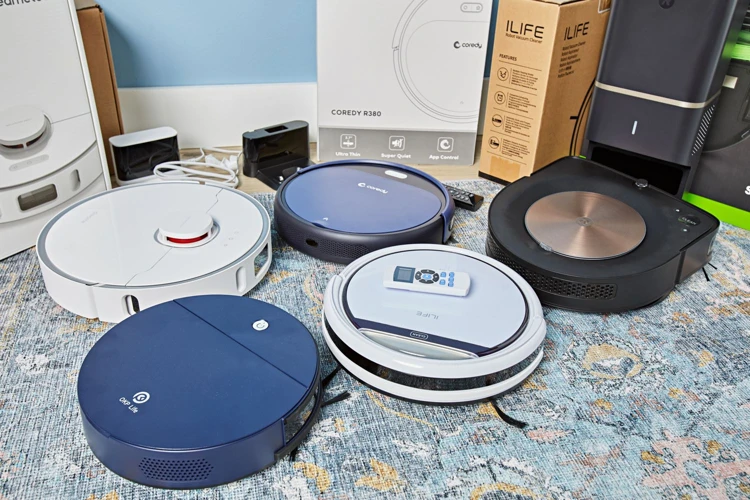
When it comes to robot vacuum cleaners, there are various types available in the market to suit different cleaning needs. From cylindrical to upright and even mopping robot vacuum cleaners, there’s no shortage of options to choose from. Each type comes with its own set of features and benefits, making it essential to understand the differences before making a purchase. So, which type of robot vacuum cleaner is right for you? Let’s dive into the world of robot vacuum cleaners and explore the various types available to help you make a well-informed decision.
Cylindrical Robot Vacuum Cleaners
Cylindrical robot vacuum cleaners are among the most popular types of robotic cleaners on the market. These devices are designed to look like small, sleek cylinders that move around your home to clean up dirt and debris. Here are some key characteristics of cylindrical robot vacuum cleaners that make them stand out from other types of robotic cleaners:
- Shape: As the name suggests, cylindrical robot vacuum cleaners are shaped like cylinders with rounded edges. This shape allows them to easily navigate through tight spaces, such as corners and under furniture, where traditional vacuum cleaners cannot reach.
- Brush Roll: Instead of using traditional vacuum cleaner brushes, cylindrical robot vacuum cleaners use a single brush roll that spins around to capture dirt and debris. This brush roll is located on the underside of the robot and is designed to pick up debris from both hard floors and carpets.
- Navigation: Cylindrical robot vacuum cleaners use cameras and sensors to navigate around your home, detecting obstacles and adjusting their cleaning path accordingly. Some models can even learn the layout of your home and create a map to optimize their cleaning efficiency.
- Battery Life: Most cylindrical robot vacuum cleaners have a battery life of around 90 minutes, which is generally long enough to clean an average-sized room. However, some models have longer battery lives, so be sure to consider this when choosing a robot vacuum cleaner.
- Price: Cylindrical robot vacuum cleaners are typically less expensive than other types of robotic cleaners, making them an affordable option for many consumers.
Cylindrical robot vacuum cleaners offer an efficient and effective way to keep your home clean without having to do the work yourself. With their unique features and affordable prices, they are a great investment for anyone looking to simplify their cleaning routine.
Upright Robot Vacuum Cleaners
Upright robot vacuum cleaners are an ideal choice for those who want a slim and sleek vacuum that can easily navigate around furniture and tight spaces. These types of robot vacuums have a more traditional design that closely resembles a classic upright vacuum.
Powerful suction: Despite its slim form factor, upright robot vacuums are equipped with powerful suction that is capable of picking up dirt, dust, and debris from every corner of your home.
Edge cleaning: One of the standout features of upright robot vacuums is the ability to clean along baseboards and edges with ease. This ensures no dirt or debris is left behind on your floors.
Cleaning modes: Upright robot vacuums typically come with multiple cleaning modes, including spot cleaning and auto cleaning. Spot cleaning mode allows you to target specific areas that require extra attention, while auto cleaning mode will clean your entire home automatically.
HEPA filters: Most upright robot vacuums come with HEPA filters that can trap up to 99.97% of particles as small as 0.3 microns. This is especially important for people with allergies or asthma.
Virtual boundaries: Some upright robot vacuums come with virtual boundaries that allow you to set up no-go zones or boundaries for your robot vacuum to avoid. This is especially useful for homes with pets or fragile objects.
Upright robot vacuum cleaners are a great choice for those who want a slim and powerful vacuum that can easily navigate around their home. They have all the features you would expect from a robot vacuum, with the added benefit of being able to clean along edges seamlessly.
Hybrid Robot Vacuum Cleaners
Hybrid Robot Vacuum Cleaners combine the features of both cylindrical and upright robot vacuum cleaners. They are equipped with a combination of brushes, which allows them to perform both sweeping and deep cleaning tasks. These robot vacuum cleaners are the perfect solution for homes with a mix of hard floors and carpets as well as pet hairs.
Here are some of the benefits of using a Hybrid Robot Vacuum Cleaner:
| Benefits | Description |
| Versatile Cleaning | They are fitted with both a rotating brush for carpets and a sweeper brush for hard floors, allowing them to efficiently clean any surface in your home. |
| Effective Pet Hair Cleaning | Hybrid Robot Vacuum Cleaners are designed to pick up pet hair, which is a common problem for pet owners. The combination of brushes ensures pet hair is effectively removed from carpets and hard floors. |
| Advanced Navigation | They have smart navigation capabilities, allowing them to move around obstacles and navigate through difficult areas such as corners and tight spaces. |
| Large Dustbins | Hybrid Robot Vacuum Cleaners have a larger dustbin capacity than other robot vacuum cleaner models, which means they can clean for longer periods without needing to be emptied. |
| Quiet Operation | These robot vacuum cleaners are designed to operate quietly, making them perfect for use during the night or while you are working from home. |
When considering purchasing a robot vacuum cleaner, Hybrid Robot Vacuum Cleaners are ideal for those with pets or a mix of surfaces in their home. However, they are generally more expensive compared to other types of robot vacuum cleaners due to the combination of features they offer.
Mopping Robot Vacuum Cleaners
Mopping robot vacuum cleaners are becoming increasingly popular due to their ability to clean and mop floors at the same time. These types of robot vacuum cleaners come equipped with water tanks and mopping pads, which are attached to the base of the robot.
The benefits of mopping robot vacuum cleaners are:
- They save time and effort by combining two tasks in one.
- They improve hygiene by removing dirt and stains on the floor.
- They are perfect for homes with pets and children as they effectively clean up spills and messes.
How Do Mopping Robot Vacuum Cleaners Work?
Mopping robot vacuum cleaners work by depositing water onto the floor through a water tank and mopping pad attached to the base of the robot. The robot then moves around the floor, cleaning and mopping up dirt and stains.
Features to Look for in a Mopping Robot Vacuum Cleaner:
- Water Tank Capacity: Look for a robot vacuum cleaner with a large enough water tank to cover the size of your floor.
- Mopping Pads: Ensure that the mop pads are made of high-quality materials, and are easily replaceable.
- Mopping Pressure: Consider the mopping pressure of the robot vacuum cleaner. This is important as some floors may require more pressure than others.
Considerations Before Buying a Mopping Robot Vacuum Cleaner:
- Type of Floor: If you have hard floors like tiles or hardwood, a mopping robot vacuum cleaner may be a good option. However, if you have carpets, then a regular robot vacuum cleaner may be more appropriate.
- Size of Home: Consider the size of your home when choosing a mopping robot vacuum cleaner. If you have a large home, then you need a robot with a longer battery life to cover the entire area.
Top Mopping Robot Vacuum Cleaner Brands:
- Xiaomi
- iRobot Roomba
- Eufy RoboVac
- Ecovacs Deebot
Maintenance and Care for Mopping Robot Vacuum Cleaners:
- Cleaning Mopping Pads: After every use, clean the mop pads to ensure they are ready for the next use.
- Emptying the Water Tank: After every use, empty the water tank to avoid mold or bacteria buildup.
- Cleaning the Robot: Regularly clean the robot vacuum cleaner to prevent dirt or debris buildup, which can affect its performance.
Mopping robot vacuum cleaners are a great investment that saves time and improves your home’s hygiene. Do your research and choose the best mopping robot vacuum cleaner for your specific needs.
Self-Emptying Robot Vacuum Cleaners
One of the newest and most innovative features of robot vacuum cleaners is the self-emptying function. This means that the vacuum cleaner can automatically empty its dustbin or dirt container, eliminating the need for manual emptying. This feature is particularly useful if you want to run your robot vacuum cleaner multiple times a day or if you have a pet that sheds a lot of hair or fur.
Self-emptying robot vacuum cleaners typically come with a docking station that doubles as a charging station and a bin emptying station. Once the robot vacuum cleaner returns to the docking station after cleaning, it will automatically empty the dustbin or dirt container into the station’s larger bin or bag. This means that you don’t have to worry about the robot vacuum cleaner running out of space or becoming less efficient due to a full dustbin.
One of the most popular self-emptying robot vacuum cleaner models is the iRobot Roomba i7+, which features a Clean Base Automatic Dirt Disposal that can hold up to 30 bins, making it perfect for homes with pets or high-traffic areas. Other brands offering self-emptying robot vacuum cleaners include the Shark IQ Robot Self-Empty and the Cecotec Conga 5090.
Self-emptying robot vacuum cleaners can save you time and effort, but they do come at a higher price point than standard robot vacuum cleaners. However, if you have a larger home, a busy lifestyle, or pets that shed a lot of hair, investing in a self-emptying robot vacuum cleaner can be a wise choice.
Robot Vacuum Cleaners with Cameras
Robot vacuum cleaners with cameras are the newest innovation in the field of home cleaning devices. These vacuum cleaners are equipped with cameras that use object detection and recognition technology to identify obstacles and objects in their path. This feature makes the robot vacuum cleaner with a camera a great choice for homeowners who want to efficiently clean their homes without the hassle of constantly monitoring the device. Here are some of the benefits of using robot vacuum cleaners with cameras:
- Accurate Navigation: Robot vacuum cleaners with cameras are able to navigate and map out the layout of your home with great accuracy. The camera helps the device to recognize and avoid obstacles, such as furniture, toys, and other objects. This helps to minimize accidents and prevents damage to the device.
- Easy Monitoring: With a robot vacuum cleaner with a camera, you can easily monitor the device’s progress from your smartphone or tablet. Some models even come with an app that lets you control the device remotely using your phone, giving you peace of mind while you’re away from home.
- Object Recognition: The camera on a robot vacuum cleaner with a camera uses object recognition technology to identify and classify objects in its path. This means that the device can detect and avoid obstacles, as well as efficiently vacuum around them.
- Customized Cleaning: With many robot vacuum cleaners with cameras, you can set up virtual boundaries using your smartphone or tablet. This helps to customize the cleaning process and ensures that the device cleans only the areas you want it to clean.
Robot vacuum cleaners with cameras are a great investment for homeowners who want to ensure efficient and thorough cleaning. They are easy to use, monitor, and customize, making them a convenient addition to any home cleaning routine.
Features to Look for in a Robot Vacuum Cleaner
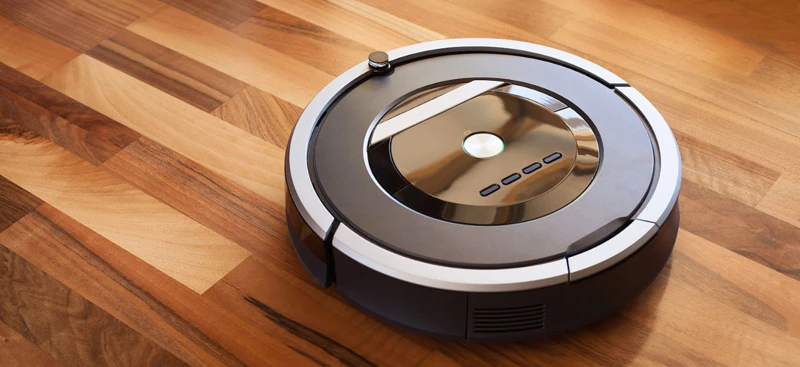
When it comes to purchasing a robot vacuum cleaner, there are a plethora of features to consider. It can be overwhelming to navigate through the various models and brands on the market. However, it’s important to understand what features will provide the most efficient and effective cleaning for your home. In this section, we’ll highlight some of the important features to look for when buying a robot vacuum cleaner. From battery life to virtual barriers and boundaries, we’ll break down what each feature entails and how it can benefit your cleaning routine.
Battery Life
The battery life is an essential factor to consider when purchasing a robot vacuum cleaner. The length of time a vacuum can operate is crucial to ensure that it covers an entire room or level of your home. Here are some crucial points to consider on battery life when selecting a robot vacuum cleaner:
- Battery Type: Robot vacuum cleaners come with either NiCad or Lithium-ion batteries. Lithium-ion batteries are preferable as they last longer and can handle more charge cycles than NiCad batteries.
- Charge Time: Consider the time required to charge the battery fully. Generally, it takes between 2-4 hours for the majority of robot vacuums to get fully charged, so make sure that the vacuum has enough time to recharge.
- Runtime: The amount of runtime supplied by the battery is crucial. A robot vacuum cleaner with a longer battery life will cover more ground, requiring less time for recharging. Make sure to examine the runtime of the vacuum before buying. The best robot vacuum cleaners offer around 120 minutes of runtime in a single charge.
- Battery Indicator: Check for a battery indicator on the vacuum. This feature informs you when the battery is low and requires the vacuum to be recharged. It guarantees that the vacuum cleaner won’t die in the middle of a cleaning session.
Considering battery life when selecting a robot vacuum cleaner is significant. Look for a vacuum with a lithium-ion battery, quick charge time, an extended runtime, and a battery indicator. These features ensure that the vacuum operates optimally and doesn’t unexpectedly shut down.
Suction Power
When it comes to choosing a robot vacuum cleaner, suction power is a crucial factor to consider. A robot vacuum cleaner’s suction power is what determines how efficiently it can pick up dirt, debris, and pet hair from different types of floors. Here is a breakdown of different suction power options you can expect from robot vacuum cleaners.
| Suction Power | What it Means |
|---|---|
| 600-800 Pa | This is considered the basic suction power that is suitable for hardwood floors and low pile carpets. |
| 900-1200 Pa | This level of suction power is ideal for medium pile carpets and can also be used on hardwood floors. |
| 1300-1800 Pa | This suction power is suitable for high pile carpets, rugs, and homes that have pets. |
| 2000+ Pa | It is the most powerful suction that can be found in robot vacuum cleaners. It is ideal for deep cleaning carpets, picking up pet hair and works well on thick shag carpets. |
It is always important to consider your floor type before selecting a robot vacuum cleaner to avoid any disappointments. If you have hardwood floors or low pile carpets, a robot vacuum cleaner with a suction power of 600-800 Pa will work well for you. However, if you have medium or high pile carpets, rugs, and a house with pets, it is advisable to go for a robot vacuum cleaner with at least 1300 Pa suction power. If you have thick carpets or shag carpets, then consider purchasing a robot vacuum with a suction power of 2000+ Pa, which will provide a deep clean. Choosing the right suction power is essential to make sure you have a clean home without any damage to your floors or carpets.
Navigation and Mapping
One of the most important features to look for in a robot vacuum cleaner is navigation and mapping. This feature allows the robot vacuum to efficiently and effectively clean your home, without running into obstacles or getting lost.
Robot vacuum cleaners have several methods for navigation and mapping, including infrared sensors, laser mapping, and camera navigation. Infrared sensors are the most basic form of navigation and work by detecting obstacles in their path, which the robot vacuum then avoids.
More advanced robot vacuums use laser mapping technology which creates a floor plan of your home to navigate and clean efficiently. These robot vacuums can even remember the layout of your home and return to their dock to recharge before completing the job.
Some robot vacuum cleaners even come equipped with camera navigation technology which uses a camera to navigate and locate itself within the home. This method works well in well-lit spaces and provides more accurate navigation results.
It is important to note that not all robot vacuums are created equal when it comes to navigation and mapping. Some models may struggle with corners or narrow spaces, while others may have trouble with dark or cluttered areas. It is important to research and read reviews before purchasing a robot vacuum to ensure that it has reliable navigation and mapping capabilities that will work for your home.
In the table below, we have outlined some of the best robot vacuum cleaners on the market with their navigation and mapping capabilities:
| Brand | Navigation and Mapping Technology |
|---|---|
| iRobot Roomba | Laser Mapping |
| Xiaomi Mi | Laser Mapping |
| Eufy RoboVac | Infrared Sensors |
| Neato Botvac | Laser Mapping |
| Shark Ion | Camera Navigation |
Navigation and mapping are essential features to consider when buying a robot vacuum cleaner. The technology used will determine how efficiently and effectively the robot vacuum can clean your home. It is important to research and understand the different navigation and mapping technologies available so you can choose a model that works best for your home.
Virtual Barriers and Boundaries
When considering a robot vacuum cleaner, one feature to look out for is virtual barriers and boundaries. These features are designed to prevent the robot vacuum from cleaning certain areas or from getting stuck in tight corners or high-transit areas.
There are several types of virtual barriers and boundaries available in robot vacuum cleaners, including:
- Magnetic Strips: These strips are placed on the floor to create a physical barrier, which robot vacuums equipped with magnetic sensors cannot cross.
- Invisible Walls: A device can create a virtual boundary around the areas to be protected or kept out of, by creating an infrared beam.
- Software-based: While some robot vacuums come with smart applications that allow users to set up virtual boundaries using an electronic map of their home. Thus, the system prohibits the robot cleaner from working in certain areas selected by the homeowner, thus confining the robot to the specific area of cleaning.
- Advanced Sensor Systems: Some robot vacuum cleaners come equipped with advanced sensors that allow them to detect and avoid obstacles on their own.
These virtual barriers and boundaries are particularly useful for pet owners, who may wish to confine the robot vacuum’s operations in areas where pet food, toys or areas having their urine can be found. They are also ideal for situations where a homeowner may want to keep their robot vacuum out of certain rooms or passageways during specific hours of the day. This results in a greater degree of control over the cleaning process.
When looking into purchasing a robot vacuum cleaner with virtual barriers and boundaries, it is important to note that some models come with this feature built-in as standard, while others may require an additional module to be purchased separately. Understanding the different types of virtual barriers and boundaries and what a particular model offers in this regard will help to make an informed purchasing decision.
Considerations Before Buying a Robot Vacuum Cleaner
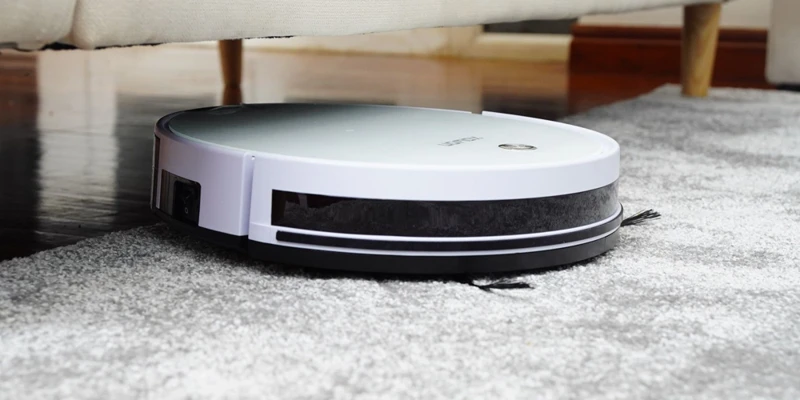
As exciting as it may be to purchase a robot vacuum cleaner for your home, there are several important factors to consider before making your purchase. With so many different models available on the market, it can be overwhelming to choose the right one that best suits your home’s size and layout, types of surfaces to be cleaned, and of course, your budget. Let’s delve deeper into some of these crucial considerations that will help you make an informed decision.
Home Size and Layout
Considering the size and layout of your home is crucial before investing in a robot vacuum cleaner. There are different types of robot vacuum cleaners in the market, each with varying capabilities and limitations.
- For small homes or apartments: Cylindrical or upright robot vacuum cleaners with basic mapping and navigation capabilities would be a suitable choice. They are generally more affordable and can efficiently clean small spaces without hassle.
- For large homes or multi-level dwellings: Hybrid robot vacuum cleaners with advanced mapping and navigation features would be better suited to handle larger spaces. Additionally, self-emptying vacuum cleaners can be a good choice for people who do not want to empty the dustbin frequently.
- For homes with many obstacles: Robot vacuum cleaners with cameras and 3D sensors would be better suited as they can map the surroundings effectively and avoid obstacles.
- For homes with carpets: Robot vacuum cleaners with high suction power are essential for efficient cleaning. Consider robot vacuum cleaners with interchangeable brushes if you have different types of carpets.
It’s important to take note of the furniture layout and any clutter on the floor as well. For instance, if you have low-lying furniture, a slim robot vacuum cleaner might be a better choice to clean beneath them. Additionally, if you have tight spaces, robot vacuum cleaners with good maneuverability, such as ones with a D-shape or a feature that allows them to clean along edges, would be an excellent choice.
Consider the layout of your home before buying a robot vacuum cleaner, as it can greatly impact the functionality and efficiency of the device.
Types of Surfaces to Clean
When considering which robot vacuum cleaner to purchase, it is important to take into account the types of surfaces that will need to be cleaned. Different robot vacuum cleaners have varying abilities when it comes to cleaning different types of surfaces.
Hard Floors: For homes with hard floors such as wood, tile, or laminate, it is important to look for a robot vacuum cleaner with a soft brush roll or a suction-only option. A robot vacuum cleaner with a spinning brush roll can scratch and damage hard floors, so it is best to avoid those.
Carpeted Floors: If your home has carpets, a robot vacuum cleaner with a powerful suction and a brush roll is necessary. The brush roll helps to dislodge dirt and debris from between the fibers of the carpet, while the strong suction pulls it up into the dustbin.
Pet Hair: For homes with pets, particularly those that shed a lot of hair, a robot vacuum cleaner with a high suction power and a tangle-free brush roll is necessary. A tangle-free brush roll prevents hair from getting caught around the brush, reducing the need for maintenance and cleaning.
Stairs: Robot vacuum cleaners are not designed to clean stairs, so it is important to consider if you have stairs in your home. In such cases, it may be necessary to supplement robot vacuum cleaning with traditional cleaning methods.
Tight Spaces: If you have many tight spaces such as under furniture, a robot vacuum cleaner with a low profile and a small size can be helpful. Additionally, robots with mapping capabilities can learn the layout of your home, avoiding obstacles and finding their way around tight spaces.
Remember, the type of surface to be cleaned is an important factor to consider when choosing a robot vacuum cleaner. Be sure to research and compare different models before purchasing to ensure that you end up with the perfect robot vacuum cleaner for your cleaning needs.
Budget
When it comes to buying a robot vacuum cleaner, budget is an important consideration. These machines come in a range of prices, from a few hundred dollars to over a thousand dollars. Here are some key factors to keep in mind when determining your budget:
- Brand: Some of the more established brands in the market tend to have higher price points. However, investing in a well-known brand may provide long-term benefits, such as better customer support and warranties.
- Features: Robot vacuum cleaners with advanced features, such as high suction power, self-emptying capabilities, and built-in cameras, tend to be more expensive. Consider which features are essential for your needs and budget accordingly.
- Home size and layout: If you have a larger home, you may need to invest in a pricier model with longer battery life and larger dustbins. Additionally, if your home has a complex layout with a lot of obstacles, you may need to look for a model with advanced navigation and mapping capabilities, which could come at a higher price point.
- Upkeep costs: Beyond the initial cost of the unit, keep in mind that robot vacuum cleaners require ongoing maintenance, such as replacing brush rolls and filters. Be sure to factor in these costs when determining your overall budget.
Ultimately, it’s important to choose a robot vacuum cleaner that fits both your needs and budget. While it may be tempting to go for the most affordable option, investing in a slightly pricier model with better features and brand support may provide better long-term value.
Top Robot Vacuum Cleaner Brands in the Market
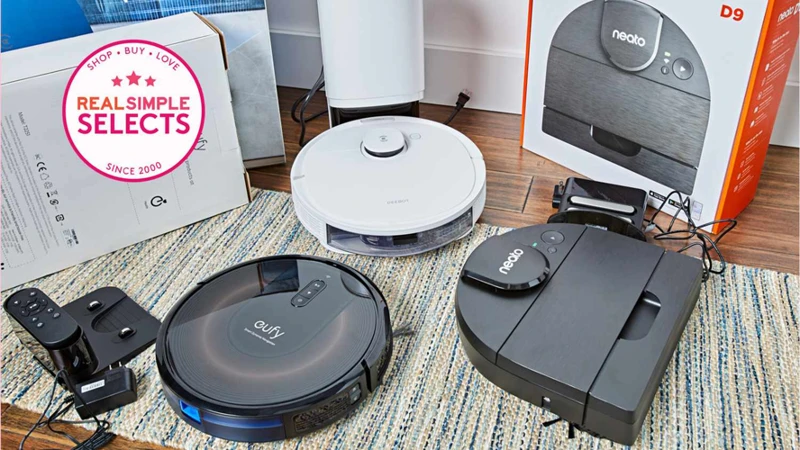
When it comes to choosing the perfect robot vacuum cleaner, it’s important to consider several factors, including its features and capabilities, as well as its price range. Many well-established brands have emerged in the market, each offering its own unique take on home cleaning automation. Here are some of the top robot vacuum cleaner brands to keep in mind:
iRobot: iRobot is one of the most well-known names in the robot vacuum industry, having introduced the first Roomba vacuum back in 2002. Their vacuum cleaners are known for their advanced features, including smart mapping and obstacle detection, as well as their sleek and modern design.
Ecovacs: Ecovacs is another brand that’s making waves in the robot vacuum industry. Their vacuum cleaners are reliable, efficient and designed to clean every corner of a house. Their latest models come with advanced mapping capability, multi-floor mapping, and even voice control through popular smart home assistants like Alexa.
Shark: Shark is a brand that’s known for its innovation in the cleaning industry, and their robot vacuum cleaners are no exception. Their robot vacuums are designed to make the cleaning process easier and more efficient. Shark IQ robot vacuum is equipped with advanced mapping and navigation system, self-emptying technology along with powerful suction for deep cleaning.
Eufy: Eufy is a brand of robot vacuum cleaners that offer an affordable alternative without sacrificing the features and functionality offered by high-end brands. They offer advanced features like voice control, powerful suction and drop-sensing technology that ensures the robot avoids collisions.
Neato: Neato robot vacuums are known for their unique D-shape design which allows it to clean corners more effectively. They also offer smart mapping and advanced navigation features. The latest models have even given signals of becoming one of the best in the industry.
These are just some of the top robot vacuum cleaner brands to consider when looking for the perfect home cleaning automation solution. Do some research to see which one offers the features and capabilities that will best suit your needs and budget. If you’re looking for a trusted and reliable brand, these five are a great place to start.
Maintenance and Care for Robot Vacuum Cleaners
Now that you’ve experienced the convenience and efficiency of using a robot vacuum cleaner for your home, it’s important to maintain and care for your trusty little robot. Just like any other home appliance, your robot vacuum cleaner requires some tender loving care to ensure it continues to function properly and efficiently. In this section, we’ll highlight some essential maintenance and care tips to help prolong the lifespan of your robot vacuum cleaner, keeping it in tip-top shape for years to come. So, let’s dive in and discover how you can keep your robot vacuum cleaner in excellent condition with a few simple and easy-to-follow steps.
Cleaning and Replacing Brush Rolls
When it comes to maintaining your robot vacuum cleaner’s efficiency, cleaning and replacing the brush rolls is one of the most important tasks. The brush rolls are responsible for dislodging dirt and debris from your floors, and as such, they are prone to getting dirty themselves. It is recommended that you clean the brush rolls every 2-3 weeks and replace them every 6-12 months depending on usage.
To clean the brush rolls, start by flipping the robot vacuum cleaner over and removing the brush rolls from their chamber. Use a pair of scissors or a seam ripper to cut any hair or string wrapped around the brush rolls. Then, use a soft-bristled brush or a toothbrush to gently scrub away any dirt and debris that has accumulated on the brush rolls. Strongly embedded debris may need to be picked out with your fingers or a pair of tweezers.
Tip: It’s important to not use water or any cleaning solutions on the brush rolls, as this can damage the bristles and reduce their effectiveness.
Once the brush rolls have been thoroughly cleaned, it’s time to replace them if they are worn out. Replacement brush rolls can be purchased directly from the manufacturer or from a third-party seller. Be sure to check the manufacturer’s recommendations for replacement frequency and compatibility with your particular robot vacuum cleaner model.
Table:
| Task | Frequency |
| Clean brush rolls | Every 2-3 weeks |
| Replace brush rolls | Every 6-12 months depending on usage |
By consistently cleaning and replacing the brush rolls, you ensure that your robot vacuum cleaner stays efficient and effective at keeping your floors clean. It may seem like a small task, but it can make a big difference in the lifespan and performance of your robot vacuum cleaner.
Emptying Dust Bins
One of the most important tasks in maintaining a robot vacuum cleaner is emptying the dust bin. This bin stores all the debris and dirt that the robot vacuum has picked up during its cleaning process, and it needs to be emptied on a regular basis to ensure optimal cleaning performance.
Why is Emptying Dust Bins Important?
When a dust bin is full, it can restrict the airflow and reduce the suction power of the robot vacuum cleaner. This can have a negative effect on the cleaning performance and result in missed spots, which defeats the whole purpose of owning a robot vacuum cleaner. Emptying the dust bin regularly ensures that the vacuum cleaner can continue to operate at its peak level of performance.
How Often Should You Empty the Dust Bin?
The frequency of dust bin emptying will depend on the size of the bin and the amount of dirt in your home. Some models have larger dust bins and can go longer before needing to be emptied, while others may require daily emptying. As a general rule, it is best to check the dust bin after every cleaning session and empty it as needed.
How to Empty the Dust Bin
Here are the basic steps to follow when emptying the dust bin of your robot vacuum cleaner:
- Locate the dust bin on your robot vacuum cleaner.
- Press the release button or tab to open the dust bin.
- Remove the dust bin from the robot vacuum cleaner.
- Dispose of the contents of the dust bin in the trash or compost bin.
- Wipe the dust bin clean with a damp cloth.
- Return the dust bin to the robot vacuum cleaner and close it securely.
Tips for Emptying the Dust Bin
To make the process of emptying the dust bin easier and more efficient, here are some handy tips to keep in mind:
- Empty the dust bin over a trash can or outside to minimize mess.
- Wear gloves to protect your hands from dust and debris.
- Use a soft-bristled brush to clean the dust bin and filter regularly.
- Be sure to replace the filter on a regular basis as per the manufacturer’s instructions.
By following these tips and regularly emptying the dust bin of your robot vacuum cleaner, you can enjoy clean floors and optimal performance from your cleaning buddy.
Filter Replacement
One crucial maintenance task for robot vacuum cleaners is filter replacement. Over time, the filter can become clogged with the dust, dirt, and debris it collects, causing the vacuum’s suction power to decrease. This issue can be easily remedied by regularly replacing the filter, ensuring that your vacuum runs efficiently for a longer period.
Below are the steps to replace your robot vacuum’s filter:
- 1. Consult the manufacturer’s instructions for guidance on the type of filter to use and how often it should be replaced.
- 2. Locate the filter compartment on your robot vacuum cleaner. This can typically be found at the back or bottom of the device.
- 3. Check the filter for visible signs of dirt and debris. A clogged filter may appear discolored, gray or even black in color, or have a visible layer of dust on its surface.
- 4. Remove the filter from the compartment, taking care not to damage it in the process.
- 5. Dispose of the old filter properly and insert a new, clean filter into the compartment.
- 6. Make sure the filter is securely in place before operating the vacuum.
Remember that regular filter replacement is essential for the proper functioning of your robot vacuum cleaner. Failure to do so can cause decreased suction power or even a complete breakdown of the device, leading to costly repairs or replacement. By following these steps and making filter replacement a regular part of your vacuuming routine, you’ll be able to preserve the longevity of your robot vacuum and maintain high cleaning standards in your home.
Conclusion
In conclusion, robot vacuum cleaners have revolutionized the way we approach home cleaning. With their advanced technology and convenience, these machines provide a wide range of benefits for users. from saving time and effort to improving health and hygiene, robot vacuums have become an essential household appliance.
There are various types of robot vacuum cleaners available in the market, each with unique features and capabilities. From cylindrical and upright models to hybrid and mopping vacuum cleaners, consumers can choose the one that meets their specific needs and budget.
Also, when considering purchasing a robot vacuum cleaner, it’s essential to take into account factors such as the layout and size of your home, types of surfaces to clean, and budget. By considering these factors, you can choose a model that would make cleaning more comfortable and more efficient.
Furthermore, taking care of your robot vacuum cleaner is vital to ensure optimal performance and longevity. Cleaning and replacing brush rolls, emptying dust bins, and filter replacements are some of the maintenance activities that could help keep your robot vacuum cleaner running smoothly for years to come.
Overall, investing in a robot vacuum cleaner is a wise choice that could provide numerous benefits for your household. With advancements in technology, the future of home cleaning seems even more promising, and we can undoubtedly expect to see more advancements in robot vacuum cleaner technology in the years to come.
Frequently Asked Questions
What is a robot vacuum cleaner?
A robot vacuum cleaner is a self-operating machine that is designed to clean floors, carpets, and other surfaces. It uses advanced technology such as sensors, cameras, and mapping to move around the house and clean efficiently.
How do robot vacuum cleaners work?
Robot vacuum cleaners work by using a combination of sensors, cameras, and mapping technology to navigate around a space. They use brushes, suction, and filters to suck up dirt, dust, and debris from floors and carpets. Some robot vacuum cleaners come with additional features like mopping, self-emptying, and boundary setting.
What are the benefits of using a robot vacuum cleaner?
Robot vacuum cleaners can save time and effort, improve health and hygiene, and enhance home decor. They are also more efficient at cleaning hard-to-reach areas, like under furniture and in corners.
What types of robot vacuum cleaners are available?
There are several types of robot vacuum cleaners available, including cylindrical, upright, hybrid, mopping, self-emptying, and those with cameras. Each style has its unique features and advantages.
What features should I look for in a robot vacuum cleaner?
When choosing a robot vacuum cleaner, consider features like battery life, suction power, navigation and mapping, and virtual barriers and boundaries. These features will impact how well the vacuum performs and how easy it is to use.
What are some considerations to keep in mind when purchasing a robot vacuum cleaner?
Before buying a robot vacuum cleaner, consider the size and layout of your home, the types of surfaces to clean, and your budget. These factors will help you choose a vacuum that meets your cleaning needs and fits your lifestyle.
What are some top robot vacuum cleaner brands in the market?
Some of the top robot vacuum cleaner brands in the market include iRobot, Roomba, Neato Robotics, ECOVACS, and Shark. Each brand has its unique features, and it’s essential to research before making a purchase.
How do I maintain and care for my robot vacuum cleaner?
To maintain and care for your robot vacuum cleaner, you should clean and replace the brush rolls regularly, empty the dustbin after each use, and replace the filter when needed. It’s also essential to clean the sensors and charging points and keep your vacuum away from obstacles.
Can robot vacuum cleaners clean stairs?
Most robot vacuum cleaners are not designed to clean stairs as they require different techniques and cleaning attachments. However, some hybrid robot vacuum cleaners can switch between vacuuming and mopping modes, making it easier to clean stairs.
Can robot vacuum cleaners work in the dark?
Most robot vacuum cleaners use sensors and cameras to navigate around the house, and they may not work effectively in low light conditions. However, some models come with advanced technology that allows them to work in the dark, like infrared sensors and night-vision cameras.

